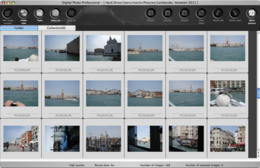 Screenshot of Canon DPP on OS X | |
| Developer(s) | Canon |
|---|---|
| Stable release | 4.19.30.0 / September 10, 2024 |
| Operating system | Windows, Mac OS X, Linux |
| Platform | (32-bit or 64-bit) |
| License | Proprietary software |
| Website | www |

Digital Photo Professional (DPP) is the software that Canon ships with its digital SLR (and some of its compacts, e.g. the Canon PowerShot S90) cameras for editing and asset management of its Canon raw (.CR2) files. It can also work with the older .CRW format of selected models, and also JPEGs and TIFFs from any source. [1] The full version ships on a CD with the camera, and updates can be downloaded from Canon's website. [2] Even though officially DPP only supports Windows and Mac operating systems, it is possible to run DPP on Linux systems by using Wine. [3]